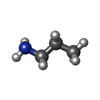+Search query
-Structure paper
| Title | Cryo-EM structures of a lipid-sensitive pentameric ligand-gated ion channel embedded in a phosphatidylcholine-only bilayer. |
|---|---|
| Journal, issue, pages | Proc Natl Acad Sci U S A, Vol. 117, Issue 3, Page 1788-1798, Year 2020 |
| Publish date | Jan 21, 2020 |
 Authors Authors | Pramod Kumar / Yuhang Wang / Zhening Zhang / Zhiyu Zhao / Gisela D Cymes / Emad Tajkhorshid / Claudio Grosman /  |
| PubMed Abstract | The lipid dependence of the nicotinic acetylcholine receptor from the electric organ has long been recognized, and one of the most consistent experimental observations is that, when reconstituted in ...The lipid dependence of the nicotinic acetylcholine receptor from the electric organ has long been recognized, and one of the most consistent experimental observations is that, when reconstituted in membranes formed by zwitterionic phospholipids alone, exposure to agonist fails to elicit ion-flux activity. More recently, it has been suggested that the bacterial homolog ELIC ( ligand-gated ion channel) has a similar lipid sensitivity. As a first step toward the elucidation of the structural basis of this phenomenon, we solved the structures of ELIC embedded in palmitoyl-oleoyl-phosphatidylcholine- (POPC-) only nanodiscs in both the unliganded (4.1-Å resolution) and agonist-bound (3.3 Å) states using single-particle cryoelectron microscopy. Comparison of the two structural models revealed that the largest differences occur at the level of loop C-at the agonist-binding sites-and the loops at the interface between the extracellular and transmembrane domains (ECD and TMD, respectively). On the other hand, the transmembrane pore is occluded in a remarkably similar manner in both structures. A straightforward interpretation of these findings is that POPC-only membranes frustrate the ECD-TMD coupling in such a way that the "conformational wave" of liganded-receptor gating takes place in the ECD and the interfacial M2-M3 linker but fails to penetrate the membrane and propagate into the TMD. Furthermore, analysis of the structural models and molecular simulations suggested that the higher affinity for agonists characteristic of the open- and desensitized-channel conformations results, at least in part, from the tighter confinement of the ligand to its binding site; this limits the ligand's fluctuations, and thus delays its escape into bulk solvent. |
 External links External links |  Proc Natl Acad Sci U S A / Proc Natl Acad Sci U S A /  PubMed:31911476 / PubMed:31911476 /  PubMed Central PubMed Central |
| Methods | EM (single particle) |
| Resolution | 3.3 - 4.1 Å |
| Structure data | EMDB-20968, PDB-6v03: EMDB-20986, PDB-6v0b: |
| Chemicals |  ChemComp-3CN: |
| Source |
|
 Keywords Keywords |  MEMBRANE PROTEIN / Pentameric Ligand-gated Ion Channels / MEMBRANE PROTEIN / Pentameric Ligand-gated Ion Channels /  POPC / Propylamonium / POPC / Propylamonium /  Nanodisc / Nanodisc /  Cys-loop receptor / Cys-loop receptors Cys-loop receptor / Cys-loop receptors |
 Movie
Movie Controller
Controller Structure viewers
Structure viewers About Yorodumi Papers
About Yorodumi Papers








